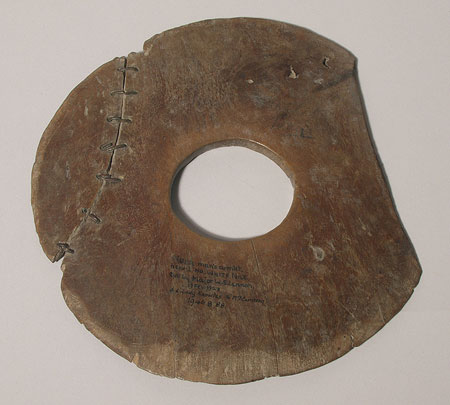Accession Number:
1946.8.88
Country:
Sudan
Region:
[Southern Sudan] Wahda near Lake No
Cultural Group:
Nuer
Date Made:
By November 1923
Materials:
Wood Plant , ?Copper Alloy Metal , ?Brass Metal
Process:
Carved , Riveted , Repaired (local) , Polished
Dimensions:
Ext. diam. = 266 mm, W across broken sides = 233 mm, Int. diam = 85 by 75 mm, th = 2 to 12 mm; rivets L = 15, W = 2 mm [RTS 9/8/2004].
Weight:
226.4 g
Other Owners:
Collected by W. Sherlock Lennon on 17th February 1923 [misread as 17th November 1923 when making the accession book entry], donated to the PRM by his sisters Kathleen Constance Averina Knowles and Mrs Cameron in August 1946 [RTS 26/8/2005].
Field Collector:
W. Sherlock Lennon
PRM Source:
Kathleen Constance Averina Knowles & Mrs Cameron
Acquired:
Donated August 1946
Collected Date:
17 February 1923
Description:
Large arm ornament, initially carved from a single piece of brown wood with a slightly convex upper surface and flat underside meeting at a sharp outer edge (Pantone 729C).
This is round in plan view, with a smaller inner hole that is slightly lentoid in shape, with a slight irregularity to its inner edge where the two sides of the hole join.
The inside face of the hole is otherwise flat, to rest comfortably against the arm.
One semicircular piece of the object has broken off from the side in the past, and been repaired locally by boring 7 pairs of holes through the broken edges, and fastening the two pieces together with a series of metal rivets.
3 of these appear to be copper (Pantone 876C), and the remaining 4 may be brass (Pantone 872C).
Each rivet is made from a strip with square to oval section, cut flat at the ends; hammering marks are visible on some of their surfaces.
The edge opposite this mended section also appears to have broken away, and is now missing.
It is a darker colour than the rest of the wood, perhaps stained deliberately or through contact with body oils, but does not appear to have been smoothed or otherwise finished off, suggesting that it was not an original feature of the object.
However note that this flat 'broken' edge would have rested against the wearer's side more comfortably than in its original shape, and may have been left unmended deliberately.
The object is therefore incomplete, with some damage to the outside edges and a crack that runs from inside to outer edge.
The surface is also discoloured, with a lighter coloured ring around the arm hole on the upper surface, and a darker ring around its underside; both sides have been polished.
It has a weight of 226.4 grams; an internal width of 85 by 75 mm; an outer diameter of 266 mm, and width of 233 mm from repaired to broken edge; the thickness varies from 2 to 12 mm.
Each rivet is approximately 15 mm long and 2 mm wide.
Collected by W. Sherlock Lennon on 17th February 1923, near Lake No, and donated to the PRM by his sisters Kathleen Constance Averina Knowles and Mrs Cameron in August 1946.
The object is currently on display in the Lower Gallery, case 40A number 10.
Rachael Sparks 30/9/2005.
Collected by W. Sherlock Lennon on 17th February 1923, near Lake No, and donated to the PRM by his sisters Kathleen Constance Averina Knowles and Mrs Cameron in August 1946.
The object is currently on display in the Lower Gallery, case 40A number 10.
Rachael Sparks 30/9/2005.
Primary Documentation:
Accession Book Entry
[p.
143]- LADY KNOWLES, 3 BRADMORE ROAD, OXFORD & MRS.
CAMERON.
Specimens collected by their brother,
CAPT
MAJOR W.S.
LENNON, from the NUER TRIBE, SUDAN, 1923.
Labelled by G.
R.
CARLINE.
Coll.
17 Nov.
1923.
1946.8.88 - WHITE NILE, near LAKE NO.
NUER man's armlet, wooden disc 10 3/4" in diam., central hole c.
3".
Piece missing from one portion, another piece has been fixed on with metal rivets.
Additional Accession Book Entry [page facing 143] - Major W. S. Lennon was District Commissioner in the Sudan.
Card Catalogue Entry - There is no further information on the tribes catalogue card [RTS 23/7/2004].
Written on object - Nuer armlet Nuer [pencil] NUER man's armlet, near L[ake] No, WHITE NILE. Coll. by Major W.S. Lennon, 17 Feb. 1923. d.d. Lady Knowles and Mrs Cameron,, 1946.8.88 [ink; note that the line giving the collection date appears to have been scraped to remove a previous marking; RTS 6/8/2004].
Additional Accession Book Entry [page facing 143] - Major W. S. Lennon was District Commissioner in the Sudan.
Card Catalogue Entry - There is no further information on the tribes catalogue card [RTS 23/7/2004].
Written on object - Nuer armlet Nuer [pencil] NUER man's armlet, near L[ake] No, WHITE NILE. Coll. by Major W.S. Lennon, 17 Feb. 1923. d.d. Lady Knowles and Mrs Cameron,, 1946.8.88 [ink; note that the line giving the collection date appears to have been scraped to remove a previous marking; RTS 6/8/2004].



